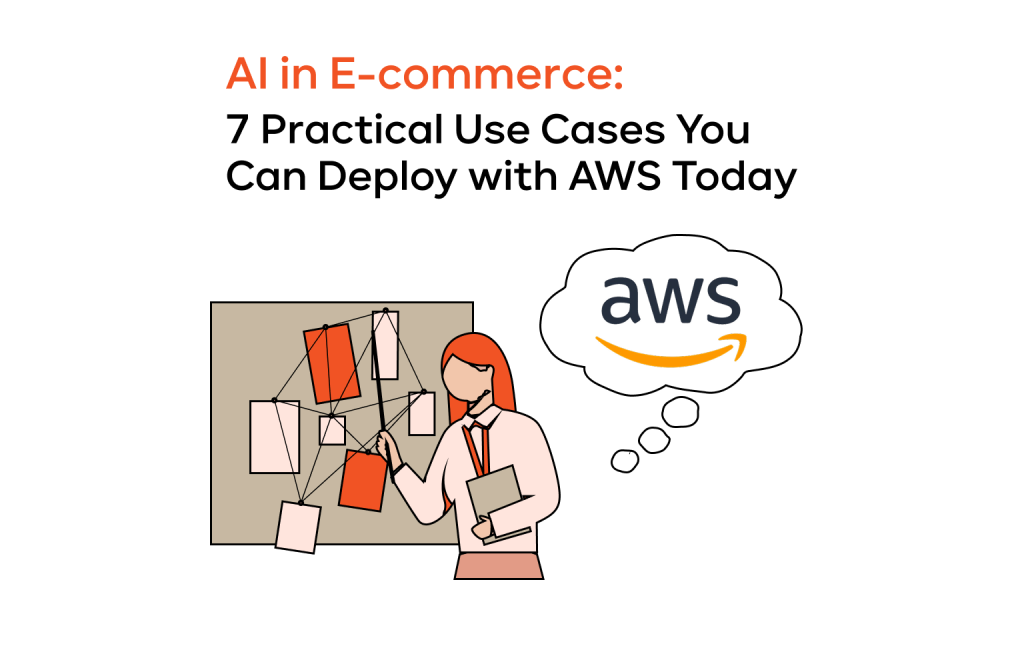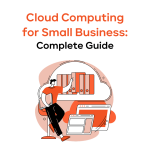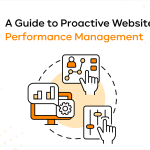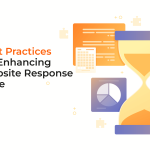Modern technology is reshaping how we sell and buy online. One of the biggest trends right now is AI in ecommerce. Not long ago, this seemed futuristic or reserved for the largest companies. Today, it’s within reach of any online business, big or small.
In this article, you’ll see seven ways AI and ecommerce connect to boost customer experiences and streamline logistics. Each use case is powered by AWS, which offers managed technologies that don’t require a special data science team. Let’s dive in.
AI has evolved from hype to a practical toolset
In the past, artificial intelligence in ecommerce sounded like science fiction. Big brands ran early experiments, but they had to build huge data pipelines. Most smaller stores felt shut out. Now, times have changed.
Cloud providers like AWS offer ready-made AI-powered ecommerce services. You can add them to your site without writing advanced algorithms or hiring a team of PhDs. Real-world data backs this up. Various reports note steady growth in e-commerce AI budgets over the past few years. Also, Forbes states that online retailers who adopt AI use cases in ecommerce see major boosts in sales and a stronger customer base.
AI adoption in e-commerce is growing, but execution lags
Despite the hype, real adoption is still spotty. Many leaders recognize the potential of AI for ecommerce, but only a small portion move beyond casual tests. One study suggests just 35% of e-retailers have rolled out AI beyond tiny pilot projects.
What causes this gap?
- Lack of data science skills: Businesses used to need advanced math and coding to launch AI.
- Unclear ROI: Some worry about investing in AI ecommerce business solutions without knowing payoff details.
- Integration hurdles: Merging AI tools with existing systems can seem complex.
These issues are real. Yet, AWS has made them easier to solve with pre-built technology and managed services.
AWS delivers business results without a data science team
AWS leads the way because it offers AI tools that are simple to configure. Many have user-friendly dashboards that hide the complicated parts. This means your DevOps or general software team can manage AI setups without diving into advanced algorithms. AWS offers:
- Low/no-code services: You won’t need a specialized data science department.
- Real-time inference: Serve recommendations or detect fraud in milliseconds.
- Scalability: Spin up more instances when you see traffic spikes. Scale down when you’re not busy.
- Broad integrations: AWS connects to many e-commerce platforms (Shopify, Magento, custom) and tools with ease.
7 proven, high-impact AI use cases you can implement today with AWS
Here’s a quick snapshot of seven AI use cases in ecommerce that we’ll explore:
- Product recommendations with Amazon Personalize
- Personalized search results using AI
- AI chatbots for customer support with Amazon Lex
- Fraud detection with Amazon Fraud Detector
- Inventory forecasting with Amazon Forecast
- AI-powered visual search and tagging with Rekognition
- Generative AI for content creation
Each one can deliver value without major cost or complexity.
Why AWS? A quick look at the ecosystem
You may wonder why some businesses choose AWS for AI in ecommerce instead of Google Cloud or Azure. The biggest reason is that AWS has a mature ecosystem with reliable support. It’s also flexible, so you can start small, then scale as you see results.
Managed AI from AWS for e-commerce
AWS provides a set of ready-made AI products. They handle the data processing and heavy lifting. Here are some key tools used to integrate artificial intelligence in ecommerce:
- Amazon Personalize: Builds tailored recommendations for shoppers.
- Amazon Forecast: Predicts future sales, inventory needs, and more.
- Amazon Lex: Creates chatbots with natural language skills.
- Amazon Fraud Detector: Alerts you when suspicious behavior occurs.
- Amazon Rekognition: Analyzes video and images for advanced search or categorization.
They all connect with Amazon S3, RDS, or other AWS services. It’s like a plug-and-play system for e-commerce artificial intelligence.
Scalability, security, and cost benefits
AWS is known for pay-as-you-go pricing. You only pay for what you use, whether that’s a small experiment or large-scale production. Security is also strong, with IAM roles and encryption features built in. When demand spikes, AWS can auto-scale your resources so you don’t lose business to slow load times. When traffic dips, you won’t stay locked into high prices.
Role of DevOps
AI used to be the domain of data scientists. That’s no longer the case. A skilled DevOps team can deploy and maintain AI in ecommerce using standard tools, SDKs, or a CI/CD pipeline. If you’re already using AWS for hosting or storage, adding AI services can be a natural extension.
_______________________________________________________________________
Want to see how to use AI in ecommerce can boost your sales?
Contact IT-Magic for a quick consultation. We’ll help you design an action plan for adopting AWS AI tools.
_______________________________________________________________________
Use case #1: Product recommendations with Amazon Personalize
Everyone has seen the “Recommended for You” or “Customers Also Bought” sections. These suggestions can boost cart value by helping shoppers find relevant items. AI in ecommerce can power these features, but in a form tailored to your own store, with the help of Amazon Personalize.
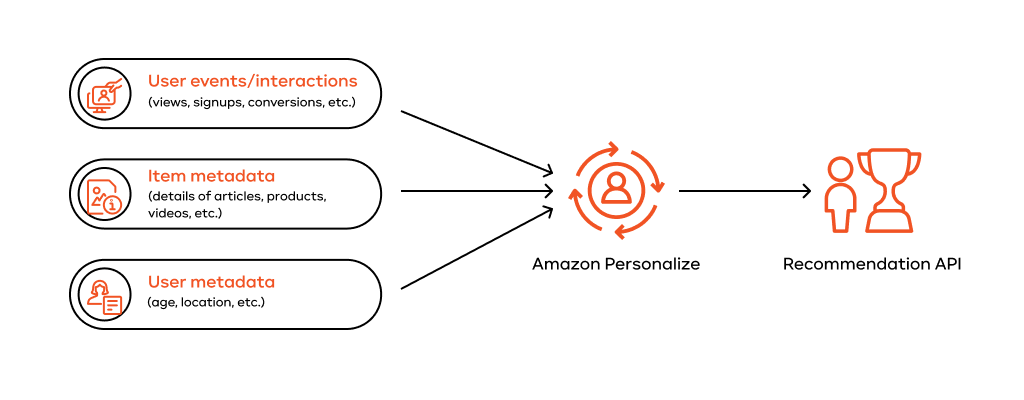
Real-time personalized recs on homepage, product pages, emails
Think about your homepage. If a returning buyer has been browsing certain categories, you can show them related products the moment they log in. The same goes for email campaigns. If you notice someone often buys eco-friendly cleaning supplies, you can highlight those deals in future newsletters.
Inputs: User behavior, purchase history, item metadata
Amazon Personalize looks at user IDs, browsing data, purchase records, and product details (like category or brand). Over time, it learns patterns of what people are most likely to buy together or next.
Outputs: “You May Also Like,” “Frequently Bought Together,” etc.
You can display:
- You May Also Like items on the product page
- Frequently Bought Together sets that appear at checkout
- Special categories like “Because You Viewed [Item X]” on your homepage
Real-time inference & A/B testing
The service runs real-time inferences. Each click or purchase can update the model. You can also run A/B tests to compare different recommendation strategies. Does your store benefit more from brand-focused suggestions or from price-focused suggestions? Test both and track conversion lifts.
How IT-Magic integrates Personalize with Shopify/Magento/custom platforms
Our process of building e-commerce AI solutions often involves:
- Setting up data exports to S3
- Configuring Amazon Personalize with your event stream
- Embedding the service’s API calls into your store’s front end
- Returning recommended products to the user interface in real time
Use case #2: Personalized search results using AI
Shoppers usually find products via search. Yet many default search engines only match text. With AI for ecommerce, you can deliver smarter results that draw on a user’s past actions, synonyms, or even context signals.
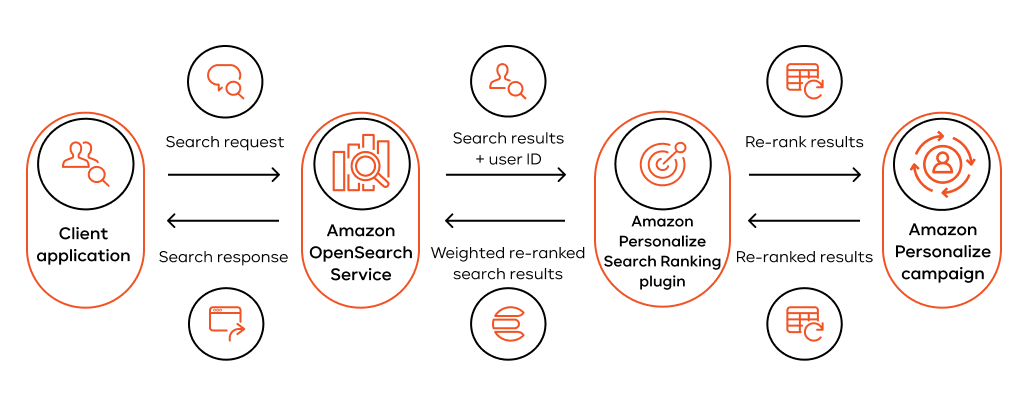
Smart ranking of search results based on intent and past behavior
An AI-powered ecommerce system can see if a user typed “running shoes” but also looked at “trail footwear” before. It might move “trail running shoes” higher in the search results. This helps them see the products they’ll likely buy sooner.
Combine Amazon OpenSearch with ML models
Amazon OpenSearch (formerly Elasticsearch) is an index-based engine that can be enhanced with machine learning. It can re-rank results on the fly. If your e-commerce AI module thinks “sneakers” and “shoes” are the same, it merges results to show a complete set of matching items.
Improve conversion and reduce bounce rate
When search accuracy increases by using AI in e-commerce, shoppers are more likely to find something they like. That means more sales and fewer site exits. If visitors can’t find an item on your site, they might leave and buy from a rival store.
Use case #3: AI chatbots for customer support with Amazon Lex
Customer support can be expensive, especially if you’re handling many repetitive queries. With AI in ecommerce, chatbots can handle routine tasks day or night.
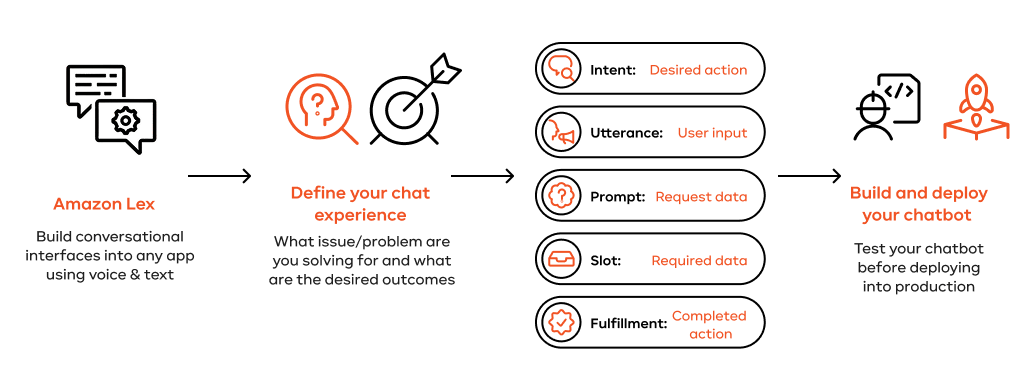
Automate FAQs, order tracking, returns, product queries
An AI chatbot can help people track their shipments or start a return. It can also answer product questions like “Is this item available in blue?” This automation allows your human agents focus on complex cases.
AWS Lex, Lambda & DynamoDB: Scalable, context-aware bots
Here’s a quick path to building an AI-powered ecommerce bot:
- Amazon Lex: Processes user input with natural language understanding.
- AWS Lambda: Grabs data from your systems and returns context-based answers.
- DynamoDB: Stores session or user info so the chatbot can remember details across visits.
Multilingual support and escalation to live agents via Amazon Connect
Lex can handle multiple languages. If the customer’s request needs a human touch, Lex can hand off the conversation to a live agent using Amazon Connect. This ensures a consistent, hassle-free customer experience.
Use case #4: Fraud detection with Amazon Fraud Detector
Fraud is a real threat in e-commerce, so a fraud detection system is a must. Manual checks may miss cunning tactics or lead to slow order processing. This is where AI in ecommerce helps, too. Amazon Fraud Detector automates this process.

Real-time scoring of transactions, logins, and account creation
Fraud Detector inspects each event:
- New signups: Flags suspicious IPs or unusual email domains
- Payments: Checks if the transaction fits your normal patterns
- Account changes: Sees if someone is trying to access or alter user details
Prevent chargebacks, promo abuse, account takeovers
Fraud can come in many forms:
- Fake orders that lead to chargebacks
- Users trying to abuse promo codes
- Hackers taking over legitimate accounts
Fraud Detector spots odd behavior using learning models trained on global data.
No ML experience needed: Deploy via console or CI/CD
The AWS console simplifies model training and deployment. If you prefer automation, you can integrate this into your DevOps pipeline. That way, new rules or updated models roll out with little manual effort.
How we help configure and tune models for business rules and accuracy
Our team at IT-Magic can adjust the model to match your risk tolerance. Some stores want fewer false positives, while others need tighter restrictions. We help you find the balance in your AI ecommerce business model. That might include building custom rules for high-value products or known risky regions.
Use case #5: Inventory forecasting with Amazon Forecast
Guessing inventory levels can feel like a guessing game. Overstock, and you drain resources. Understock, and you lose sales. AI-based e-commerce forecasting reduces that guesswork.
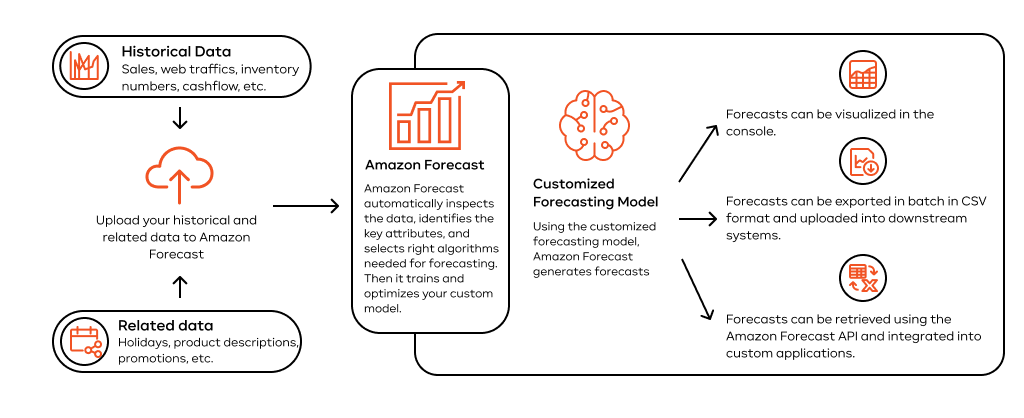
Predict demand and avoid stockouts/overstock
Amazon Forecast uses advanced algorithms to measure trends. It goes beyond simple time-based averages. It can spot spikes caused by holiday traffic or special deals.
Inputs: Historical sales, seasonality, promotions, external factors
You feed in:
- Past sales data
- Seasonal patterns (e.g., holiday peaks)
- Promo schedules
- External factors like weather, regional events, or shifts in shipping times
Outputs: SKU-level forecasts and procurement recommendations
The model predicts demand for each SKU over different time frames. This can help you decide when to reorder, how many units to keep in stock, or which items are trending. You can also tie it to your procurement system for automated purchase orders.
Integration with supply chain platforms
Forecast can link to an ERP or a smaller third-party tool. That creates a seamless flow of data, so you’re not stuck doing manual updates. With AI in ecommerce, real-time updates keep your pipeline in sync.
Use case #6: AI-powered visual search and tagging with Rekognition
Images are central to how people shop online. Sometimes, a user wants to search by an image but can’t quite find the right words. That’s where AWS and artificial intelligence in ecommerce offer the help of Amazon Rekognition.
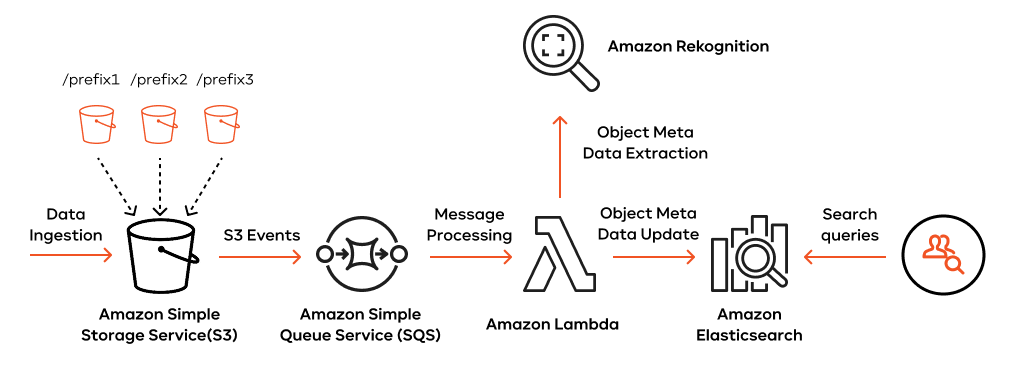
Let customers search using images instead of text
Visual search means a shopper can upload a photo of something they saw on social media or in a friend’s post. The AI looks for the same or similar product in your catalog. This feature can give your store a cutting-edge feel and boost customer satisfaction.
Auto-tagging large product catalogs
If you have thousands of images, manually tagging them is a huge job. Rekognition automates it. It can identify color, shape, category, or brand logos. When your store organizes items more accurately, product discovery improves.
Boosts product discovery and UX
Well-tagged items and image-based searches can drive more sales. People don’t have to guess a product’s name. They simply show the AI-powered ecommerce system what they want. This simplicity results in a smoother user journey.
Use case #7: Generative AI for content creation
Generative AI is no longer just a trend. It’s a practical tool for marketing, product listings, and more.
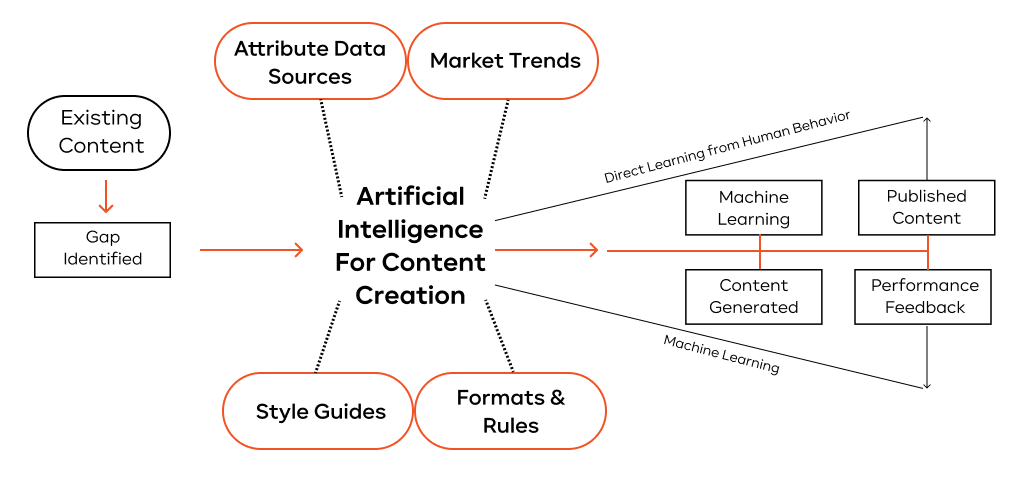
Auto-generate descriptions, FAQs, intros & emails
An online store needs a lot of content:
- Detailed product listings
- FAQs that address common customer concerns
- Promo or upsell emails for new lines or seasonal events
Generative AI can draft these in seconds, saving time for your editorial team.
Bedrock access to foundation models
AWS offers Amazon Bedrock, which gives you access to large foundation models. You won’t need huge internal resources to train them. Bedrock lets you tap these models through an API. You can also use them for tasks like rewriting product text to fit a certain brand tone.
Prompt engineering & fine-tuning for brand voice
Prompt engineering helps you guide the AI on what you want. You can say, “Write a short, friendly product description,” or “Produce a witty email for coffee lovers.” Over time, you can refine or “fine-tune” these models to fit your store’s voice and style.
Scalable via API and serverless architecture
When your site or marketing campaign needs more content, you can scale up. AWS’s serverless approach means you pay only for the compute time you use. If you have a big seasonal push, generate your new content, then scale down after the rush.
How to prioritize the right use case for your business
You’ve seen seven ways to apply AI in ecommerce. Which one should you tackle first? The choice depends on your data readiness, your target outcomes, and how fast you want results.
Evaluate by ROI, time-to-market, and available data
Ask yourself:
- Which project might deliver the biggest immediate payoff?
- What data do you have on hand?
- How quickly can you run a pilot?
If your store faces many support tickets, AI chatbots might be the low-hanging fruit. If search is your biggest pain point, focus on an AI search upgrade.
Start with one pilot – scale from there
A pilot helps you see what’s possible. Maybe you implement personal recommendations or a chatbot for a small subset of products or categories. If the metrics look promising, you can expand it across your entire platform. This strategy lets you control risk while gaining AI experience.
Our recommendation
We often suggest starting with personalized recommendations or chatbots. They offer immediate results and build momentum.
At IT-Magic, we know how to use AI for ecommerce success. Our experts start with a discovery session to see what data you have and what goals matter most. Then we craft a pilot with AWS that’s suited to your unique situation.
Final thoughts
AI in ecommerce doesn’t have to be complex or expensive. Cloud-based solutions mean the barrier to entry is lower than ever. Even if you don’t have a massive budget, you can try out one or two of these AI use cases in ecommerce to gauge the impact. AWS manages the complexity. You see the results.
Many companies are intrigued by how ecommerce and AI work together, but are not sure where to begin. That’s where a short call can help. We’ll talk about your strategy, review your infrastructure, and propose a plan.
Find your best-fit use case - book a free discovery call
See what AI-powered ecommerce could do for your business with IT-Magic. We’ll guide you in picking the right AI project for your store and implement it for you.
FAQ
How long does it take to integrate AWS AI into an existing e-commerce platform?
Timelines vary based on the use case. For product recommendations or chatbots, you could see results in two to four weeks if your data is ready. More complex projects, like detailed demand forecasting, may take a bit longer to gather and prep data. Still, AWS’s pre-built services help you move faster than if you built everything from scratch.
Can I test AI solutions before full deployment?
Yes. AWS lets you test features in a sandbox or run an A/B test. You can try these tools with a fraction of your site traffic to confirm they work well. If the test looks good, you can expand. This reduces risk and helps you tweak the system for the best performance.
What if we’re not sure which use case to start with?
In that case, we hold a discovery session to learn about your business. Together, we identify the areas with the biggest pain points or potential gains. We then propose the most effective pilot project to deliver quick value. That way, you see tangible wins from AI and ecommerce early on.
How often do AI models need to be updated or retrained?
It depends on the service. Amazon Personalize can retrain automatically when it sees new clicks or purchases. Other systems, like Amazon Forecast, might retrain on a set schedule. This ensures they stay accurate. You can also bake model updates into your CI/CD pipeline, so everything stays in sync with your shifting business needs.
